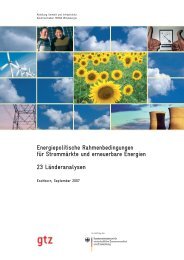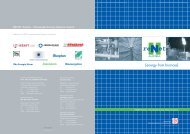K u rzfassu n g sb an d - Graz University of Technology
K u rzfassu n g sb an d - Graz University of Technology
K u rzfassu n g sb an d - Graz University of Technology
- Keine Tags gefunden...
Erfolgreiche ePaper selbst erstellen
Machen Sie aus Ihren PDF Publikationen ein blätterbares Flipbook mit unserer einzigartigen Google optimierten e-Paper Software.
64 Energieinnovation 2006<br />
3.2.4 „ Analysis <strong>of</strong> the regional development <strong>of</strong> a hydrogen infrastructure<br />
using a Germ<strong>an</strong> energy system model supported by<br />
a Geographic Information System (GIS)”<br />
Michael Ball, Philipp Seydel*, Martin Wietschel (Fraunh<strong>of</strong>er Institut für<br />
Systemtechnik und Innovationsforschung) 1<br />
Due to the high oil <strong>an</strong>d gas prices <strong>an</strong>d environmental concern during the last years, the different<br />
energy systems are being forced to close r<strong>an</strong>ks. The scarcity <strong>of</strong> resources such as bi<strong>of</strong>uels leads to<br />
increasing competition between the power sector, the heating sector <strong>an</strong>d the tr<strong>an</strong>sport sector. A<br />
projected increase in global energy dem<strong>an</strong>d, the economic <strong>an</strong>d geopolitical implications <strong>of</strong> future<br />
shortcomings in the supply <strong>of</strong> oil <strong>an</strong>d natural gas, <strong>an</strong>d consequently concerns about energy supply<br />
security have recently put the discussion about hydrogen as a future energy carrier back on the<br />
agenda. Of all the alternative fuels presently being discussed with respect to meeting the long-term<br />
dem<strong>an</strong>d for automotive fuels, hydrogen seems particularly promising. Currently, strategies for the<br />
implementation <strong>of</strong> a hydrogen economy are being developed in the EU, the USA <strong>an</strong>d Jap<strong>an</strong>. If<br />
hydrogen turns out to be the future fuel, then the connection between the electricity, heating <strong>an</strong>d<br />
tr<strong>an</strong>sport energy dem<strong>an</strong>d will be even closer th<strong>an</strong> it is at present due to the wide r<strong>an</strong>ge <strong>of</strong> potential<br />
hydrogen feedstocks.<br />
The MOREHyS 2 model, developed by Fraunh<strong>of</strong>er ISI in cooperation with DFIU, is a bottom-up, mixedinteger,<br />
linear optimisation model with exogenous dem<strong>an</strong>d for electricity, heat <strong>an</strong>d hydrogen. The<br />
model determines the minimum cost <strong>of</strong> production <strong>an</strong>d new investments given some constraints for<br />
each year such as maximum emission levels or regional limitations for generation capacities, e.g. <strong>of</strong><br />
wind or hydropower, which might affect the current energy mix. The objective function used for the<br />
optimisation is cost minimisation for the whole region each year (myopic approach). For the structure<br />
<strong>of</strong> MOREHyS, see Figure 1.<br />
Infrastructure costs for the tr<strong>an</strong>sport <strong>an</strong>d distribution <strong>of</strong> hydrogen are partially determined by the<br />
topological characteristics <strong>of</strong> the considered regions, while production costs for hydrogen are <strong>of</strong>ten<br />
site-specific. In order to take these “real world” costs into account in the <strong>an</strong>alysis <strong>of</strong> a hydrogen-based<br />
tr<strong>an</strong>sport system, MOREHyS is linked to a GIS (Geographic Information System). The GIS is used for<br />
the estimation <strong>of</strong> the costs <strong>of</strong> different hydrogen tr<strong>an</strong>sport modes (trailer, pipeline, etc.) for selected<br />
geographical areas <strong>an</strong>d production technologies (e.g. hydrogen production from wind-<strong>of</strong>fshore parks in<br />
northern Germ<strong>an</strong>y). This is done by taking into account aspects such as characteristics <strong>of</strong> the terrain<br />
(urb<strong>an</strong>, mountainous, along major raods) or relative dist<strong>an</strong>ces between production sites <strong>an</strong>d dem<strong>an</strong>d<br />
centres. The GIS provides cost data for the tr<strong>an</strong>sport matrix used in the energy system model.<br />
As hydrogen production has to compete for the same primary energy carriers as conventional heat<br />
<strong>an</strong>d electricity generation, the model assesses the resulting impact on the national energy mix <strong>an</strong>d the<br />
subsequent consequences for electricity utilities. This includes, for example, the potential utilisation <strong>of</strong><br />
power pl<strong>an</strong>ts for hydrogen production (especially IGCCs), the effects <strong>of</strong> <strong>an</strong> increased dem<strong>an</strong>d for<br />
natural gas on its price development (taken into account by me<strong>an</strong>s <strong>of</strong> cost-potential curves) <strong>an</strong>d<br />
capacity constraints <strong>of</strong> gas pipelines. A further aspect is the availability <strong>an</strong>d long-term relev<strong>an</strong>ce <strong>of</strong><br />
renewable energies for the production <strong>of</strong> hydrogen via electrolysis compared to the conventional feedin<br />
<strong>of</strong> electricity. In addition, the economic <strong>an</strong>d environmental impacts <strong>of</strong> integrating hydrogen<br />
production <strong>an</strong>d distribution into the Germ<strong>an</strong> energy system are assessed, such as the impact on CO 2<br />
emissions <strong>an</strong>d primary energy consumption.<br />
1 Fraunh<strong>of</strong>er Institute Systems <strong>an</strong>d Innovation Research (Fraunh<strong>of</strong>er ISI),<br />
Breslauer Str. 48, 76139 Karlsruhe, Germ<strong>an</strong>y, Phone +49 721/6809-352,<br />
e-mail: philipp.seydel@isi.fraunh<strong>of</strong>er.de, www.isi.fraunh<strong>of</strong>er.de;<br />
2<br />
MOREHyS (Model for Optimisation <strong>of</strong> Regional Hydrogen Supply); ongoing research at the<br />
<strong>University</strong> <strong>of</strong> Karlsruhe: “Integration <strong>of</strong> a H2 economy into the Germ<strong>an</strong> energy system”;





